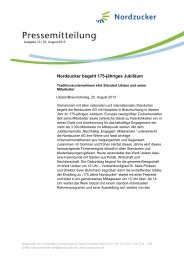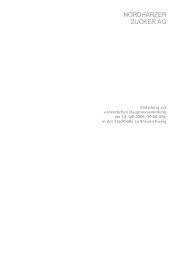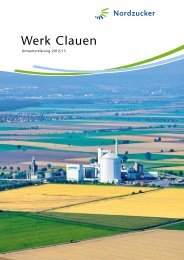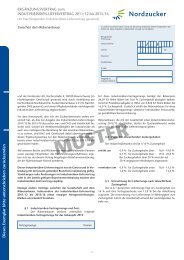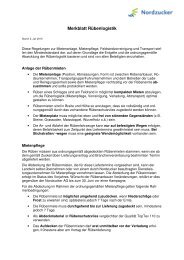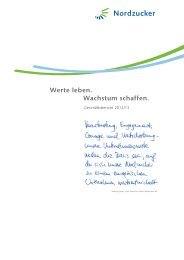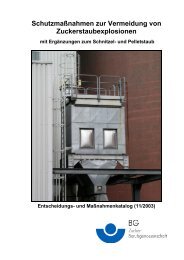downloads - Nordzucker AG
downloads - Nordzucker AG
downloads - Nordzucker AG
Create successful ePaper yourself
Turn your PDF publications into a flip-book with our unique Google optimized e-Paper software.
Not a record year<br />
In almost all of <strong>Nordzucker</strong>’s growing<br />
areas, beet was sown later in<br />
2013 than in previous years. How<br />
big is the actual “delay”?<br />
Dr. Pörksen: Across the Group, beet<br />
seed was sowed between two and three<br />
weeks later this year than in the previous<br />
year. However, when compared<br />
with the five-year average, we are only<br />
an average of ten days late. There was<br />
a late spring in all growing countries,<br />
which was particularly pronounced in<br />
Germany and Finland, where beet sowings<br />
were completed on average three<br />
weeks later than in 2012.<br />
What is the current situation in the<br />
beet fields? Do you see any chance<br />
for stocks to make up lost ground?<br />
Dr. Pörksen: Definitely not. The delay<br />
can no longer be recovered. Persistently<br />
cold weather, a lot of rain and not<br />
enough sunshine meant that the crops<br />
persisted for too long in the two-leaf<br />
and four-leaf stage. This was compounded<br />
by growth delays brought on by the<br />
outstanding effect of herbicides on the<br />
moist soil during 2013. Moreover, many<br />
of our growers in Germany had to deal<br />
with heavy rainfall at the end of May,<br />
including some flooded fields and siltation.<br />
Fortunately, there were not many<br />
cases of complete losses. Nevertheless,<br />
beet growth has been impacted by<br />
extremely warm, sunny weather conditions<br />
with sufficient rainfall, which<br />
meant it was also possible to partially<br />
compensate for the late sowing here<br />
and, as in Sweden, to achieve stock<br />
levels on a par with the five-year average.<br />
In Poland and Slovakia, warm<br />
weather conditions following sowing<br />
together with sufficiently moist soil conditions<br />
and regular rainfall ensured rapid<br />
field emergence and good development<br />
of crops. Growth here was also slowed<br />
by a cold snap in the latter part of May.<br />
these additional factors in many of these<br />
areas.<br />
From today’s perspective, what<br />
does this mean for the 2013 beet<br />
harvest and campaign?<br />
Dr. Pörksen: It is clear that this beet year<br />
will not be a record year. <strong>Nordzucker</strong><br />
will process a significantly smaller beet<br />
harvest. If everything goes well, we will<br />
achieve maximum yields on a par with<br />
the five-year average. The decision as<br />
to when we will begin processing the<br />
beets will depend on the results of the<br />
lifting tests in August. What I can say is<br />
that, from today’s perspective, I do not<br />
see any reason to start the campaign<br />
early. <br />
Interview by Susanne Dismer-Puls<br />
Overall, stock levels in both countries<br />
are healthy. Approximately half of the<br />
areas sowed saw row closure by 10<br />
June, with the remaining areas following<br />
around ten days later.<br />
Harvest outlook: about average<br />
Overall, beet development in Germany<br />
and Denmark at the end of June points<br />
to a generally below-average beet year<br />
in 2013. <strong>Nordzucker</strong> expects average<br />
yields in Sweden, Finland and Lithuania,<br />
and solidly average yields in Eastern<br />
Europe. <br />
sdp<br />
The amount of<br />
beet to be processed<br />
will be<br />
much smaller in<br />
this campaign.<br />
<strong>Nordzucker</strong> tests yield<br />
potential of the paper<br />
pot method<br />
Early sowing and a long period of<br />
growth are the keys to success for sugar<br />
beet cultivation. The longer the frostsensitive<br />
beet can grow, the greater the<br />
chances are of achieving above-average<br />
yields. To what extent can the yield be<br />
increased through longer growth periods<br />
made possible by using young beet<br />
plants grown in advance? <strong>Nordzucker</strong><br />
investigates this question as part of its<br />
20 · 20 · 20 initiative in a field trial in<br />
Schleswig-Holstein.<br />
Eight-week head start<br />
In Kronprinzenkoog in Dithmarschen,<br />
around 7,000 young beet plants were<br />
transferred from the greenhouse on<br />
10 April 2013. The plants were transferred<br />
using a cabbage transplanter by<br />
the farmers Björn Göser and Hans-Reimer<br />
Thießen and have a growth advantage<br />
of up to eight weeks over the sugar beet<br />
usually drilled in Schleswig-Holstein.<br />
The plants were sown early in the<br />
greenhouse in paper pots on 19 and<br />
26 February. The paper pots are around<br />
15-centimetre-high containers made<br />
from paper that dissolve in the soil.<br />
sdp<br />
Akzente July 2013 13







